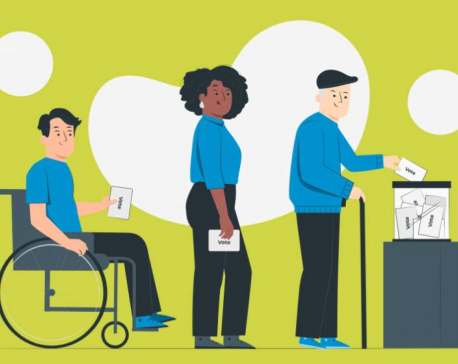
OR
Opinion
Breaking Down Myths about Employees with Disabilities
Published On: April 29, 2023 08:30 AM NPT By: Pralhad Gairapipli


Pralhad Gairapipli
The author is a communications for development practitioner, driven by both passion and profession.news@myrepublica.com
From working as a team with people with disabilities, I have learned about their difficulties finding employment. But by talking to and learning from them, I saw how talented and valuable they are in the workforce.
International Labor Day, also known as May Day, is celebrated every year on May 1st to honor workers' contributions and achievements worldwide. The holiday has its roots in the late 19th century. It served as a day to recognize workers' struggles and sacrifices for better working conditions, fair wages, and improved labor laws. Regardless of the varying origins of Labor Day celebrations around the world, the message and significance remain the same - to commemorate workers' significant contributions towards society's development.
As we move towards a more inclusive society, it is crucial to address the myths and biases surrounding disability in the workplace. These misconceptions lead to discrimination and exclusion, limiting people with disabilities’ potential to contribute fully to society. It is essential to acknowledge that individuals with disabilities possess unique skills, talents, and perspectives that can benefit any workplace. Providing accommodations and creating an inclusive work environment can lead to a diverse and dynamic workforce, benefiting both employees and the organization. On this important day, let us recognize and celebrate the contributions of all workers, including those with disabilities, to build a more equitable and inclusive society.
The United Nations Convention on the Rights of Persons with Disabilities (UNCRPD) is a treaty that aims to ensure all persons with disabilities enjoy fundamental human rights and freedoms, including the right to work and employment. It recognizes that individuals with disabilities should have equal access to job opportunities and treatment at work. The convention calls for affirmative measures to promote disability employment and eliminate discrimination. Similarly, Nepal's Disability Rights Act provides legal protections for individuals with disabilities and requires employers to make reasonable accommodations to ensure their full participation in the workforce. The act also prohibits discrimination based on disability in all aspects of employment, such as hiring, promotion, and termination.
Through working as a team with people with and without disabilities, I have gained insights into their challenges with finding employment, job retention and progress. However, by learning from them, I have come to appreciate their value in the workforce. As someone who has worked closely with individuals with disabilities, I can say that myths about their abilities are wrong and unfair. To break down these barriers, employers can create a welcoming and supportive workplace culture that allows everyone to participate fully. In the following section, we will explore some of these myths in more detail.
One of the most common myths about people with disabilities is that they are difficult employees. This myth believes that individuals with disabilities require more accommodations and support than people without disabilities. This can be seen as a burden on employers. However, research has shown that employees with disabilities have higher rates of job retention and lower absenteeism rates than people without disabilities counterparts. A study conducted by the International Labour Organization in Nepal found that employees with disabilities had lower absenteeism rates than employees without disabilities. This was because 8.7% of employees with disabilities reported absenteeism compared to 12.1% of employees without disabilities. This suggests that employees with disabilities are not only capable but also highly committed to their work.
Another myth is that people with disabilities are too expensive to employ. This myth assumes that accommodations and support for employees with disabilities are always costly. However, research has shown that many accommodations are low-cost or even free, and the cost of not employing individuals with disabilities can be much higher in terms of missed opportunities and the potential loss of valuable talent. A study by the World Bank found that the costs associated with excluding people with disabilities from the workforce are much higher than the costs of providing accommodations and support. By excluding disabilities from the workforce, countries can lose up to 7% of their GDP. This highlights the significant economic and social benefits of inclusive employment policies.
A third myth is that people with disabilities aren't reliable. This myth assumes that individuals with disabilities are more likely to miss work or be late due to their disability. However, this is not always the case. Research has shown that individuals with disabilities have similar levels of attendance and punctuality to their counterparts without disabilities. In a study conducted by the International Labour Organization in Nepal, employees with disabilities had similar attendance and punctuality rates as employees without disabilities. This suggests that people with disabilities are just as reliable as those without disabilities.
A fourth myth is that people with disabilities can't carry a full workload. This myth believes that individuals with disabilities are not physically or mentally capable of working at the same level as employees without disabilities. However, research has shown that individuals with disabilities are just as capable of carrying a full workload as employees without disabilities. A study by the International Labor Organization in Nepal found that employees with disabilities reported similar job demands as employees without disabilities. Additionally, research has shown that individuals with disabilities can bring unique skills and perspectives to the workplace, contributing to a more diverse and innovative workforce.
Last but not least, there is the myth that people with disabilities cannot be managers or leaders. This myth assumes that individuals with disabilities lack the skills and abilities required to lead and manage others. However, this is not true. Individuals with disabilities can bring unique perspectives to leadership positions, contributing to a more inclusive and diverse workplace culture.It is time to challenge the myths surrounding people with disabilities in the workplace and recognize their capabilities as valuable employees. Research has shown that individuals with disabilities are just as reliable, capable, and committed as their counterparts without disabilities. By providing the appropriate accommodations and support, employers can tap into a valuable pool of talent and contribute to a more inclusive and diverse workforce.
You May Like This

Elections and People with Disabilities
The access of people with disabilities to vote in elections is an extremely critical human right issue! ... Read More...

Over 600 PWDs receive ID cards in Rasuwa
RASUWA, March 13: A campaign to distribute identity cards to people with disabilities (PWDs) in Rasuwa district has started in... Read More...

Call to implement social security act
KATHMANDU, Aug 16: The trade unions of the country have called on the government and employers to implement the workforce Contribution-based... Read More...
Just In
- KMC to organize a month-long skill fair from May 1
- Birgunj Metropolis collects over Rs 360 million in revenue
- NEPSE plunges below 2,000 points after one and a half months; daily turnover declines to Rs 2.10 billion
- AI Index Report-2024: AI still behind humans on complex tasks like competition-level mathematics
- Daiji-Jogbudha road construction at snail’s pace
- Govt fails to adopt podway technology despite its potential in Nepal
- Jhulaghat border crossing in Baitadi to remain closed from this evening
- Universities will be free from partisan interests: Education Minister


















Leave A Comment